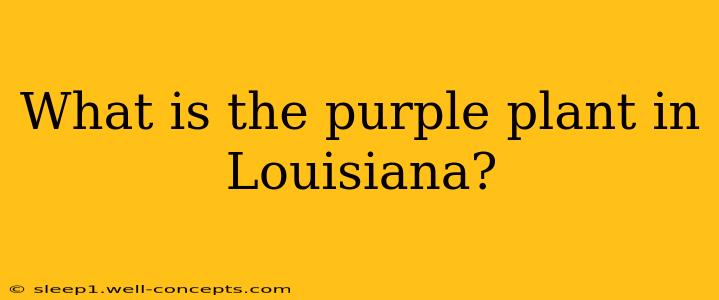Louisiana, with its diverse ecosystems ranging from swamps and bayous to pine forests and prairies, boasts a rich tapestry of plant life. While the question "What is the purple plant in Louisiana?" lacks specificity, we can explore some of the most common and striking purple plants found throughout the state. Pinpointing a single plant requires more information, such as location, time of year, and physical characteristics (leaf shape, flower type, etc.). However, this guide will help you identify potential candidates.
Common Purple Plants Found in Louisiana
Louisiana's humid subtropical climate supports a vibrant array of flowering plants, many of which exhibit stunning purple hues. Here are some likely suspects you might encounter:
1. Purple Coneflower (Echinacea purpurea)
This popular native wildflower is easily recognizable by its daisy-like blooms with drooping purple petals surrounding a prominent central cone. Purple coneflowers are relatively drought-tolerant and thrive in full sun, making them a common sight in many Louisiana landscapes, including roadsides and meadows.
2. Salvia Species
Several species of Salvia boast vibrant purple flowers. These plants are known for their attractive blooms and ability to attract pollinators like hummingbirds and butterflies. Depending on the specific Salvia species, you might find them in gardens, natural areas, or even along the edges of wetlands. Some varieties are cultivated, while others are native to the region.
3. Purple Passionflower (Passiflora incarnata)
This striking vine showcases intricate purple and white flowers with a unique structure. It's known for its medicinal properties and is a relatively common sight in various habitats across Louisiana, often climbing fences or other structures.
4. Various Wildflowers
Louisiana's diverse habitats support a wide range of wildflowers, many of which exhibit purple tones during certain times of year. These could include species from the Petunia, Verbena, or Aster families, among others. Identifying these often requires a closer look at their specific characteristics and habitat.
5. Ornamental Plants in Gardens and Landscapes
Many cultivated plants featuring purple flowers are popular choices for Louisiana gardens. These could include varieties of petunias, irises, salvias, and many others. The specific species will vary depending on the gardener's preferences and the local microclimate.
Narrowing Down the Possibilities: What to Consider
To accurately identify the purple plant you've seen, consider these factors:
- Location: Where did you see the plant? Was it in a garden, a wetland, a forest, or a roadside?
- Time of year: When did you see the plant? Different plants bloom at different times.
- Physical characteristics: What did the plant look like? Describe the shape and size of the leaves, the structure of the flower (shape, size, number of petals), and the overall height and growth habit (bushy, vine-like, etc.).
- Photographs: A clear photograph can be invaluable in identification.
Utilizing Resources for Identification
Several resources can assist in identifying Louisiana's purple flora:
- Local nurseries and garden centers: Experts at these locations can offer valuable insights based on their experience with plants in the region.
- Online plant identification tools: Many websites and apps allow you to upload photos and receive potential identifications.
- Field guides to Louisiana plants: These guides provide detailed descriptions and illustrations of various plant species found in the state.
By considering these factors and utilizing available resources, you can increase your chances of successfully identifying that intriguing purple plant you encountered in Louisiana. Remember that a detailed description, including photographs, is crucial for accurate identification.

